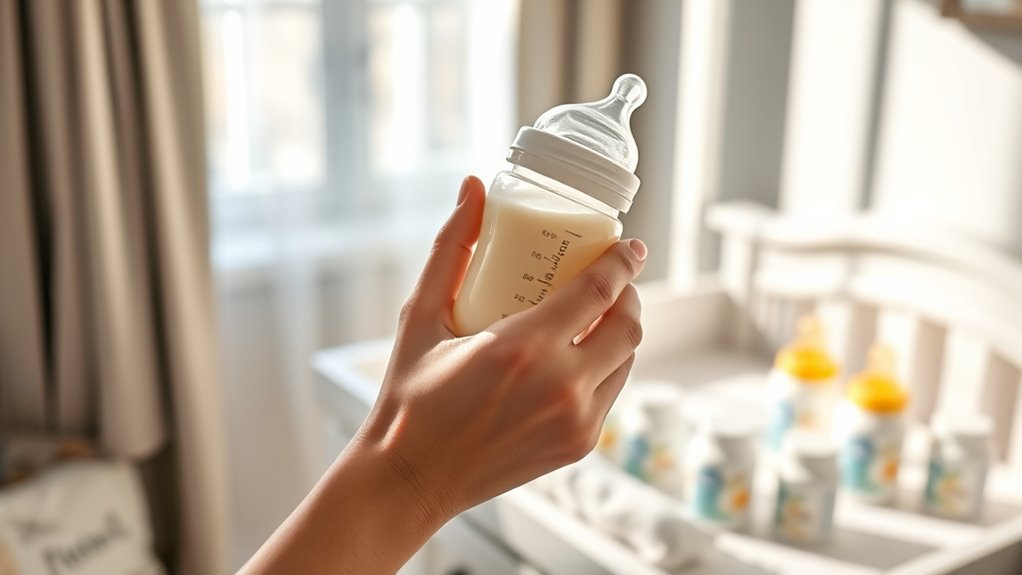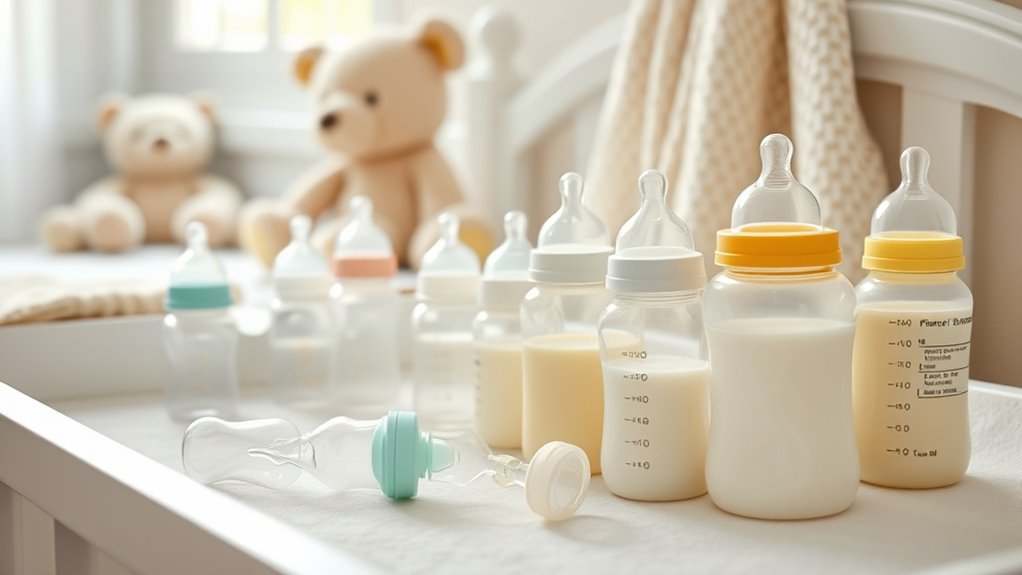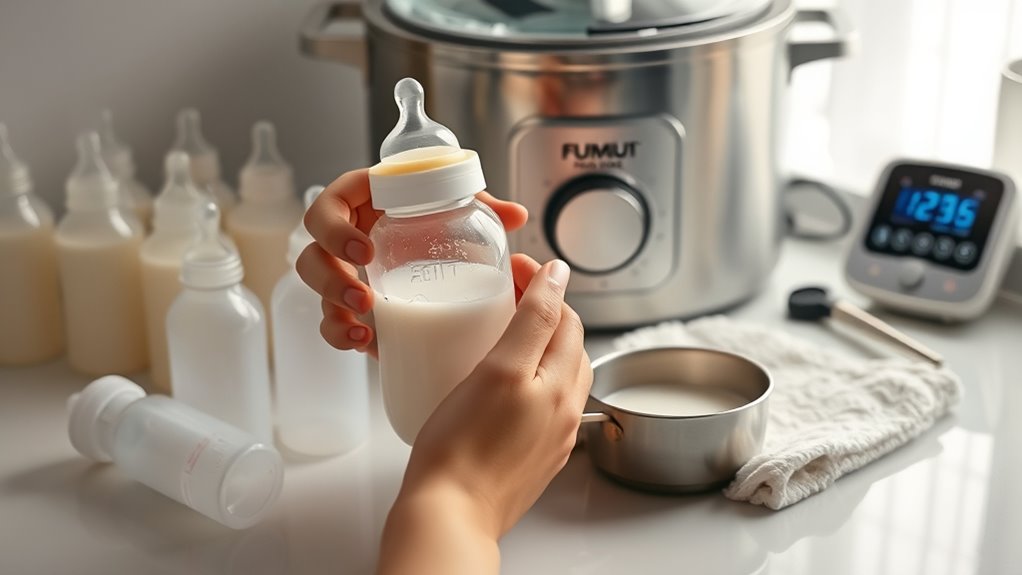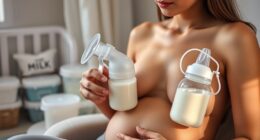To select the right bottle and formula, consider your baby’s age, feeding needs, and safety concerns. Opt for BPA-free bottles made of glass, plastic, or silicone, with nipples that mimic breastfeeding. Choose a formula based on your baby’s health and pediatrician advice, storing and preparing it properly. Watch for signs your baby is feeding well, like steady swallowing and weight gain. Keep exploring for detailed tips to guarantee a safe, comfortable feeding experience.
Key Takeaways
- Select BPA-free bottles made from glass, plastic, or silicone based on durability, safety, and baby’s preferences.
- Choose nipple flow rates appropriate for your baby’s age to ensure comfortable feeding without air intake.
- Match bottle size to your baby’s age and feeding habits to prevent waste and manage feeding effectively.
- Pick formula type—cow’s milk, soy, or specialized—based on your baby’s health needs and pediatrician advice.
- Thoroughly clean and sterilize bottles daily, using proper techniques to maintain safety and prevent infections.
Types of Baby Bottles and Their Features

When choosing a baby bottle, understanding the different types and their features can help you find the best option for your little one. Bottle material varies, with options like glass, plastic, and silicone, each offering different durability and safety benefits. Glass bottles are sturdy and free from chemicals, but they’re heavier and breakable. Plastic bottles are lightweight and shatterproof, though some may contain BPA or other chemicals unless labeled BPA-free. Silicone bottles are flexible and soft, mimicking natural feel. Another key feature is the nipple flow rate, which determines how quickly your baby drinks. Newborns typically need slow flow nipples, while older babies can handle medium or fast flow options. Choosing the right combination of bottle material and nipple flow rate supports your baby’s feeding needs.
Factors to Consider When Selecting a Baby Bottle

Choosing the right baby bottle involves more than just selecting a preferred material or nipple flow rate. You need to take into account several factors to ensure comfort and safety.
- Bottle material: Opt for BPA-free plastic, glass, or silicone that’s durable, lightweight, and easy to clean. Your choice impacts safety and ease of handling. Selecting materials that are resistant to chemical leaching is crucial for your baby’s health. Additionally, consider how well the material withstands sterilization processes to maintain hygiene.
- Nipple shape: Select a shape that mimics breastfeeding, such as wide or angled nipples, to help your baby latch comfortably and reduce confusion. A well-designed nipple can also prevent air intake, minimizing gas and discomfort.
- Bottle size: Choose a size appropriate for your baby’s age and feeding habits, preventing waste and making feedings more manageable. Larger bottles may be suitable for older infants who feed less frequently.
- Safety considerations: Always verify that the materials used are free from harmful chemicals and meet safety standards, as safety standards are essential to protect your baby from potential hazards. Ensuring the bottle complies with recognized safety regulations can provide peace of mind. Moreover, staying updated on AI security advancements helps manufacturers improve safety features in baby bottles.
Types of Baby Formula and How to Choose the Right One

Selecting the right baby formula can seem overwhelming with so many options available, but understanding the different types helps simplify the process. There are formulas designed as breastfeeding alternatives, including cow’s milk-based, soy-based, protein hydrolysate, and specialized formulas for sensitivities or allergies. Each type offers unique benefits depending on your baby’s needs. When choosing, consider your baby’s health, preferences, and your pediatrician’s advice. Proper formula storage tips are essential to keep it fresh and safe—store unopened cans in a cool, dry place and prepared bottles in the refrigerator, using them within 24 hours. Knowing the differences among formulas helps you make an informed choice, ensuring your baby receives the right nutrition while making feeding times more manageable. For example, self-watering pots can be practical for busy parents who want to maintain a healthy indoor garden without constant care. Understanding formula types and how they relate to different baby nutritional needs can further help you select the most appropriate option for your infant’s specific nutritional needs. Additionally, being aware of astrological influences might offer insights into your baby’s temperament and preferences, complementing your choice of formula. Being familiar with toilet functionality and maintenance may also be helpful for parents managing household routines alongside feeding schedules.
Tips for Preparing and Sterilizing Bottles and Formula

Preparing and sterilizing bottles and formula properly is essential to keep your baby safe and healthy. To guarantee safety, follow these tips:
- Wash bottles and parts thoroughly with hot, soapy water, paying attention to bottle material safety and avoiding harmful residues.
- Sterilize bottles daily using boiling water or a sterilizer, especially if your baby is under three months or has a weakened immune system.
- Use freshly boiled water to prepare formula, mixing it according to manufacturer instructions, and consider breastfeeding alternatives if formulas don’t suit your baby’s needs.
- Staying informed about data privacy challenges helps ensure that your health data and personal information are protected during these processes. Additionally, being aware of skin health benefits associated with proper skincare can help prevent irritation from cleaning products and sterilizers.
Signs That Your Baby Is Feeding Well and When to Seek Advice

Pay attention to your baby’s feeding cues and behaviors, as they can tell you whether they’re getting enough nourishment. A good sign your baby is feeding well is steady milk intake, evidenced by regular swallowing and swallowing sounds during feeds. Your baby should seem satisfied after feeding, releasing the bottle and appearing relaxed. Watch for cues like turning away from the bottle or losing interest, which indicate fullness. Proper weight gain and wet diapers also signal adequate feeding. However, if your baby shows persistent fussiness, refuses to feed, or isn’t gaining weight as expected, it’s time to seek advice. Trust your instincts and consult your pediatrician if you’re concerned about their milk intake or feeding behaviors. Proper feeding ensures your baby’s healthy growth and development.
Frequently Asked Questions
How Often Should I Replace My Baby’S Bottles and Nipples?
You should replace your baby’s bottles and nipples regularly to guarantee safety and hygiene. Experts recommend sterilizing bottles frequently, especially if your baby is under three months or has a weakened immune system. Nipple replacement frequency depends on usage; typically, you should change nipples every 3 to 4 weeks, or sooner if they become cracked, discolored, or sticky. Regular bottle sterilization and timely nipple replacement help prevent bacterial buildup and maintain your baby’s health.
Are There Eco-Friendly or Reusable Bottle Options Available?
Think of choosing baby bottles like planting a tree—your choice impacts the future. Yes, eco-friendly materials and reusable options are available, making it easier to reduce waste. Many brands offer bottles made from sustainable plastics or glass, which you can sterilize and reuse effortlessly. By opting for these eco-conscious choices, you’re nurturing your baby and the planet, creating a greener, healthier environment for everyone.
Can I Mix Different Formulas or Bottles?
You might wonder if you can mix different formulas or bottles. It’s best to verify for formula compatibility because some formulas react differently when combined. When switching bottles, consider bottle material options like glass, BPA-free plastic, or silicone to suit your preferences. Always follow manufacturer guidelines to ensure safety. Mixing formulas isn’t generally recommended unless advised by your pediatrician, and sticking to one type helps prevent digestive issues.
What Are Common Feeding Position Mistakes to Avoid?
Feeding your baby is like steering a delicate dance. To avoid common mistakes, make certain you’re in a proper latch position, keeping the bottle at a gentle angle. This helps prevent choking and allows your baby to control the flow of milk. Avoid tilting the bottle too much or holding it in an awkward position. Staying attentive to your baby’s cues and maintaining good posture guarantees a comfortable, safe feeding experience for both of you.
How Do I Handle Bottle Feeding During Travel or Outings?
When handling bottle feeding during travel or outings, keep your travel tips in mind. Use a portable feeding set that’s easy to carry and assemble. Pack extra bottles, formula, and a clean cloth for convenience. Find a comfortable, quiet spot to feed your baby, ensuring they’re upright to prevent choking. Staying organized and prepared helps make feeding smooth, even on the go, so your baby stays happy and well-fed.
Conclusion
Now that you know how to choose the right bottle and formula, you’re almost ready to nourish your little one with confidence. But remember, every baby is unique, and their needs may change over time. Keep an eye on their cues and stay flexible—there’s always more to learn. The next stage of your feeding journey might surprise you. Are you prepared for what’s coming next? Stay tuned, because your baby’s comfort and health depend on it.










